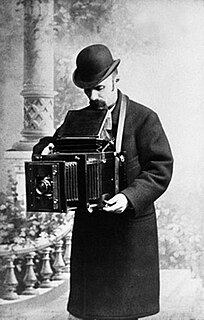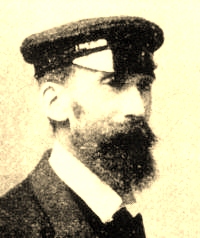Related Research Articles

Photography is the art, application, and practice of creating durable images by recording light, either electronically by means of an image sensor, or chemically by means of a light-sensitive material such as photographic film. It is employed in many fields of science, manufacturing, and business, as well as its more direct uses for art, film and video production, recreational purposes, hobby, and mass communication.

Alfred Stieglitz was an American photographer and modern art promoter who was instrumental over his 50-year career in making photography an accepted art form. In addition to his photography, Stieglitz was known for the New York art galleries that he ran in the early part of the 20th century, where he introduced many avant-garde European artists to the U.S. He was married to painter Georgia O'Keeffe.

Sergey Mikhaylovich Prokudin-Gorsky was a chemist and photographer of the Russian Empire. He is best known for his pioneering work in colour photography and his effort to document early 20th-century Russia.

The American Civil War was the most widely covered conflict of the 19th century. The images would provide posterity with a comprehensive visual record of the war and its leading figures, and make a powerful impression on the populace. Something not generally known by the public is the fact that roughly 70% of the war's documentary photography was captured by the twin lenses of a stereo camera. The American Civil War was the first war in history whose intimate reality would be brought home to the public, not only in newspaper depictions, album cards and cartes-de-visite, but in a popular new 3D format called a "stereograph," "stereocard" or "stereoview." Millions of these cards were produced and purchased by a public eager to experience the nature of warfare in a whole new way.

Eugène Atget was a French flâneur and a pioneer of documentary photography, noted for his determination to document all of the architecture and street scenes of Paris before their disappearance to modernization. Most of his photographs were first published by Berenice Abbott after his death. Though he sold his work to artists and craftspeople, and became an inspiration for the surrealists, he did not live to see the wide acclaim his work would eventually receive.

Erotic photography is a style of art photography of an erotic, sexually suggestive or sexually provocative nature.

William Henry Jackson was an American photographer, Civil War veteran, painter, and an explorer famous for his images of the American West. He was a great-great nephew of Samuel Wilson, the progenitor of America's national symbol Uncle Sam. He was the great-grandfather of cartoonist Bill Griffith, creator of Zippy the Pinhead comics.

Henry Hamilton Bennett was an American photographer famous for his pictures of the Dells of the Wisconsin River and surrounding region taken between 1865 and 1908. The popularity of his photographs helped turn the city of Wisconsin Dells, Wisconsin into a major tourist destination.

A real photo postcard (RPPC) is a continuous-tone photographic image printed on postcard stock. The term recognizes a distinction between the real photo process and the lithographic or offset printing processes employed in the manufacture of most postcard images.
Ivo Peters BEM was an English railway photographer and filmmaker. Peters spent his life in Bath, Somerset and is best known for his amateur photographs and cine films of steam railways in the British Isles, particularly of the Somerset and Dorset Railway.

Carl Oswald Bulla or Karl Karlovich Bulla was a German-Russian photographer, often referred to as the "father of Russian photo-reporting".

Ray Jerome Baker was an American photographer, film maker and lecturer. His photographs are among some of the earliest professional works in Humboldt County, California and later in Hawaii where his work focused on the people of that state.
Colin Telfer Gifford is a British railway photographer. Gifford pioneered the "New Approach" to railway photography in the 1960s during the declining years of steam. This approach relies heavily on abstraction and sought to encapsulate the dirty working atmosphere of the railway.
Henry Cyril Casserley was a British railway photographer. His prolific work in the 1920s and 1930s, the result of travelling to remote corners of the railway network in the United Kingdom and Ireland, has provided subsequent generations with a valuable source of illustrations for books and magazines.

William Umpleby Kirk (1843–1928) was a pioneer photographer of the late Victorian period. He was born in Hull and grew up in nearby Market Weighton where, in the early 1870s, he set up his first photographic studio. Examples of his work from that period have survived and are collected.

The Locomotive Publishing Company was an English publishing house, specialising in railway topics. It was noted for publishing Locomotive Magazine, amongst many other highly regarded titles. It was also notable as one of the first stock photo libraries, in this case specialising in railway images.

Martin John Ridley was an English Victorian/Edwardian photographer based in Bournemouth. Many of his photographs were used to produce picture postcards of the seaside towns and attractions in the South of England. Many of these postcards are still circulating at postcard fairs and acquired by collectors. They are usually identifiable by the initials "MJR" followed by a serial number. Several thousand of his original glass-plate negatives still exist and are being academically catalogued. A large sub-section of these negatives, featuring scenes in Wales, is held by the National Library of Wales in Aberystwyth.
William Harwood was a photographer and keen collector of postcards of the region surrounding Criccieth, Wales, part of the United Kingdom.

John Moran was a pioneering American photographer and artist. Moran was a prominent landscape, architectural, astronomical and expedition photographer whose career began in the Philadelphia, Pennsylvania area during the 1860s.
A large collection of photographs was created by two generations of photographers based in Barrow in Furness. The collection is currently being catalogued before being deposited in Cumbria Archives, where they will be available through their online catalogue CASCAT.
References
- ↑ Lake, G. H. Railways October 1942.
- ↑ Tidey, H. Gordon (1954). Those were the trains. London: Ian Allan.
- 1 2 Alsop, John (December 1999). "H. Gordon Tidey Postcards". Railway Postcard Collectors Circle. 27: 24–5.
- ↑ Tidey, H. Gordon (1930). "Railway photography". Railway Magazine. 67: 322–3.
- 1 2 Jackson, Alan A. (September 1999). "H. Gordon Tidey Postcards". Railway Postcard Collectors Circle. 26: 4–6.
- ↑ Dalling, Graham (December 1999). "H. Gordon Tidey". Railway Postcard Collectors Circle. 27: 26.